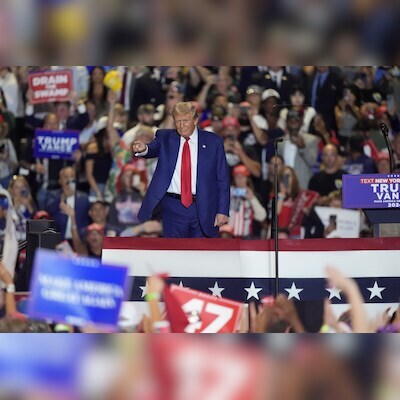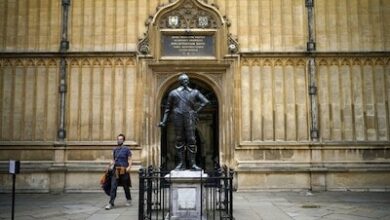Donald Trump’s new tariff plan falls well short of filling his budget hole | World News

)
Trump has promised to use sweeping new tariffs to fund everything from tax cuts to child care. (Photo: PTI)
Donald Trump has promised to use sweeping new tariffs to fund everything from tax cuts to child care. But economists say the new import charges are unlikely to create anything close to the revenue boom he would need.
The Peterson Institute for International Economics calculates that a 10 per cent tariff on all imports, plus 60 per cent on China – ideas Trump has floated if he wins in November — could raise $225 billion a year, without factoring in blowback from fresh trade tensions. Analysis by Bloomberg Economics based on an across-the-board tariff of 20 per cent, a figure that’s also been mentioned by Trump, arrives at potential annual revenue of between $300 and $400 billion.
By comparison, the tax and spending promises that Trump has rolled out so far would add somewhere between $5.2 trillion and $6.9 trillion to federal deficits over the next decade, according to analysis by the Penn Wharton Budget Model.
Reconciling the gap won’t be easy in an era of already surging government debt. What’s more, some tariffs like the ones Trump slapped on China — are expressly designed to reduce or redirect trade flows. To the extent they succeed, it means there are fewer imports to be taxed, and less revenue.
Scott Bessent, a Trump adviser and the founder of hedge fund Key Square Group, says his own calculations are that a 10 per cent across-the-board tariff and a doubling of duties on Chinese imports would raise between $2.5 trillion and $3 trillion over 10 years.
Bessent acknowledges that tariff collection would likely decline over time, since the primary goal would be to realign trade and bring more production inside the US. But he says that shift would create domestic jobs and generate growth that will help fill the government’s coffers, even if the corporate tax rate is cut to 15 per cent as Trump has proposed.
“It’s a good thing if the tariff revenue goes down and if the revenue from income taxes goes up because of more production at home,” Bessent said. “The idea is not to replace income tax,” he said, but to create a “hybrid model.”
)
)
Trump has also proposed funneling money from tariffs into a sovereign wealth fund that could invest in manufacturing hubs, defense and medical research.
“President Trump successfully imposed tariffs in first term AND cut taxes for hardworking Americans here at home – and he will do it again in his second term,” Karoline Leavitt, the Trump campaign’s national press secretary, said in a written response to questions. “President Trump’s plan will result in millions of jobs and hundreds of billions of dollars returning home to American shores.”
The campaign also points to a recent study by the Coalition for Prosperous America, a group that has long pushed for higher tariffs, which found a 10 per cent universal tariff would create 2.8 million US jobs and raise enough cash to fund tax refunds for lower- and middle-income households.
Still, skeptics say the fiscal windfall will fall short. One case study is the China tariffs that Trump imposed in his first term and the Biden administration has broadly maintained.
US customs revenues from China surged after the tariffs were imposed in 2018, according to the Peterson analysis, but then peaked in 2022 and dropped sharply last year.
That reflects shifts in trade as businesses shuffle their supply lines to evade the tariff dragnet, while consumers seek lower-taxed alternatives.
And the higher the tariffs, the bigger the shifts. Trump’s proposed new charge on China would wipe out about 90 per cent of the $600 billion trade between the world’s two biggest economies by the time of the next US election, according to Bloomberg Economics.
“The big takeaway is that raising tariffs lowers imports, offsetting some of the boost to customs revenue from higher rates,” said Maeva Cousin at BE. “That tends to lead to declining receipts over time.”
‘Hard Decisions’
Meanwhile, trading partners likely won’t take the tariffs lying down. If they retaliate by taxing American goods, the result could be a blow to US exporters and a drag on growth.
Power Curbers — a company based in Salisbury, North Carolina – is an example of the kind of business that is vulnerable to trade-war escalation. It makes concrete paving equipment that’s used for roads, curbing and highway safety barriers, and generates about one-quarter of revenues from overseas.
Stephen Bullock, the company’s president, said that retaliatory tariffs would hurt investment and jobs at the firm, which employs 120 workers in the US.
“Our best growth opportunity is global and in developing countries that are making infrastructure investments,” he said. “That’s where our opportunities are, and tariffs could severely impact our ability to grow. We would have to make hard decisions.”
Broader damage to exports would likely slow the economy, which translates into higher government spending on things like benefits, and lower tax revenue – offsetting the fiscal gains from tariffs.
“When you are hitting the economy with negative shocks, it automatically hurts the budget,” said Kimberly Clausing at the Peterson Institute.
Trump’s first-term China tariffs were slammed by many Democrats at the time, but they’ve subsequently won bipartisan approval. In fact, President Joe Biden has approved tariff increases on billions of dollars in Chinese goods to go into effect this month.
That hasn’t prevented Vice President Kamala Harris, who became the Democratic candidate for the Nov. 5 election after Biden withdrew in July, from attacking Trump’s latest tariff proposals. She’s sought to label them as a “Trump sales tax” that would raise costs for middle-class families by thousands of dollars a year.
Whatever kind of tax they are, the tariffs would fall a long way short of filling the hole in the government’s budget, said Irwin. “If you want to fund the federal government with tariffs, that’s not going to happen,” he said.
First Published: Sep 20 2024 | 8:57 AM IST




